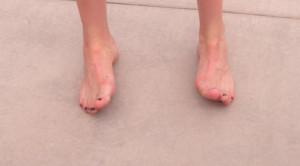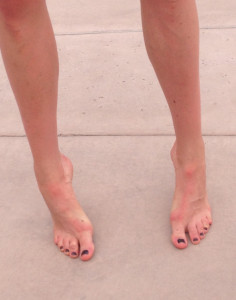Baring it all; Running Feet-uring no shoes!
The simplicity of running is surely one of it’s greatest appeals? Our ancestors were made to run. All you need is a good pair of lungs and a strong set of legs and you’re ready to go. Step out the door and let your feet guide you through morning sunrises, along open meadows, up majestic mountains. Be the first footsteps to break fresh snow, or the last to see the moonlight glow! It’s all rather poetic! But of course we humans like to make things a little more complicated so we throw in an expensive pair of running shoes, a gps watch, an brace for our i-pod…the list goes on. These modern gismos have made running a trendy sport, and arguably made running appealing to a much wider audience. Some would say such gismos enhance the experience and in some cases I would agree, but I’ve also got another view point. Consider this…
Why not enhance the experience by improving our bodies so that we can run faster, longer and more efficiently? Why not craft our anatomical tools into quality running machines? Every runner, no matter what level, knows that injury is all part of the game. It’s an unfortunate but inevitable consequence of our glorious sport. We are not invincible. Yet there are hundreds of methods of injury prevention out there, and once you weave through the scientific waffle you might just find some methods that get us back to the simplicity that running is all about.
Like a tree can only grow strong through sturdy roots, we as runners also need to have a robust set of feet. A growing phenomenon amongst running geeks is the emergence of the toe shoe. The rise of the five-finger-glove reflects a change in both scientific and commercial thinking about the level of cushioning that we need in our shoes. In the nineties top shoe brands trumpeted the need for stability and cushioning. All running injuries could be fixed with a good dose of structure, whether that be in your trainer or through an orthotic. Yet now we are backtracking to the simplistic and frankly more believable view that maybe we are better off running in less supportive shoes – are ancestors did just fine without any shoes so why shouldn’t we? Well i’m all for this. To me it’s logical but i’m not about to head out for a 10mile road run barefoot. We need to be realistic and take this message with a pinch of salt.
Supportive shoes not only align our running movement, they also reduce the amount of impact we put through our legs each time our foot hits the ground. How do you think your body is going to respond to the extra impact that running without this cushioning will bring? Many physiotherapists would agree that the minimalist trend has given their industry a hefty boost! However, done correctly and with a good dose of patience, it is possible for us to regain a little of the simplicity that running is all about and move toward lighter gear. The starting point is to un-do some of the ‘damage’ that a life in shoes has done to our feet. Enhanced arch support and layers of sponge have allowed our feet to become lazy – you could say that at the moment, even when we run, our feet are real life couch potatoes! Fallen arches and flat footedness are extremely common in the western world, while plantar-faciaitis is a common term tossed around injured joggers. In order to get our feet ‘off the couch’ we need to make them strong and there are a few simple but effective exercises that we can use to do this:
- Picking up marbles: This is as simple as it sounds. All you need is a set of marbles and a cup. Scatter the marbles on the floor and use only your toes to lift them into the cup one-by-one.
- Scrunching in the sand (towels work too if you aren’t in walking distance of the Bahamas): If you have a beach near you the ideal is to simply stand with your feet in the sand and scrunch your toes up, hold, then release and stretch them as far apart as you can. Repeat until your toes feel fatigued. If you can’t get in the sand, do it on your lawn or on a bathroom towel.
- Big toe roll throughs: Start with your weight on your heels and roll through the side of your foot, up to your small toe, and across your toes until you come to stand on all tiptoes (including that immobile big toe!). Hold this position for a few seconds, and then roll back the way you came. Repeat this motion in a slow and controlled manner for a minute at first and then try to extend towards 5mins. Do it while you wait for the kettle to boil or for your computer to load.


- Theraband toe stretching: Get yourself a flat theraband and attach one end to a strong table leg or equivalent. Loop the other end around the top of your toes and sit on the ground at a distance that allows the band to be taught but not pulling your toes off a 90 degree angle to the floor. Then flex your toes towards your knees slowly, hold for 3-5seconds, then return to 90 in a controlled manner. Now point your toes against the resiatnce, hold and return to 90. Do this ten times as a set, and progress from 1 to 5 sets in your own time. For a quick fix you can use a towel instead of a theraband and simply hold the ends to get that needed tension.


- One foot balancing: Simple, stand on one foot and work those little tendons through balance. My favourite way to keep this in a daily routine is to do it while I brush my teeth – a minute on each leg and your done! Hitting two birds with one stone!

It’s also worth pointing out that us runners tend to have very immobile big toes which can be a further source of injury and prevent our feet adopting the normal running motion. Before you slip on your trainers sit down an grab each big toe and just twist it around! Move it up and down gently and wiggle the joint to keep some fluidity in there!
On top of incorporating these exercises into your training routine why not try spending more time barefoot. When you are in the house take your shoes off and let your feet breathe and get used to supporting your body. Then build up to a bit of running on grass barefoot. Why not try doing the last five minutes of your run along your garden lawn – go easy and lightly, focusing on rolling through your big toe and enjoy the sensation of running free!
A warning though; Patience is key though in this game and not all of us are going to respond positively to free-foot running styles. There is nothing wrong with keeping your trainers firmly on your feet but we can all benefit from having stronger running roots!
